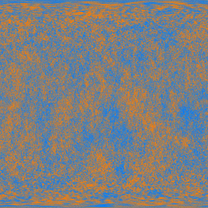


The successor of Cosmic Microwave Background v1. Made with Chatgpt 5, which yielded a much better result much more quickly.
#!/usr/bin/env python3 """ Generate a 4096×4096 image of the Cosmic Microwave Background (CMB) that uses EVERY 24-bit RGB color exactly once, using real Planck data (Planck 2018 PR3). Colab-friendly version: - No argparse (hardcoded settings below) - Uses os.getcwd() instead of __file__ - Automatically downloads from working IRSA URLs with fallback options Requires: pip install numpy healpy astropy pillow """ import os import sys import math import time import urllib.request import numpy as np from urllib.error import HTTPError from PIL import Image import healpy as hp from astropy.io import fits # ---------- Settings ---------- W = H = 4096 CHUNK_ROWS = 256 # Output file OUT_FILE = "cmb_allrgb_4096.png" # FITS file path (empty = auto-download) FITS_PATH = "" # leave blank for auto-download # URLs (working IRSA paths, component-maps/cmb/) BASE_URL = "https://irsa.ipac.caltech.edu/data/Planck/release_3/all-sky-maps/maps/component-maps/cmb/" CANDIDATES = [ "COM_CMB_IQU-smica-nosz_2048_R3.00_full.fits", # preferred (no tSZ) "COM_CMB_IQU-smica_2048_R3.00_full.fits", # with tSZ "COM_CMB_IQU-commander_2048_R3.00_full.fits", # alternative ] # ---------- Download & FITS Reading ---------- def download_with_fallback(local_path: str): for fname in CANDIDATES: url = BASE_URL + fname try: print(f"Attempting download: {url}") urllib.request.urlretrieve(url, local_path) print(f"Downloaded successfully: {local_path}") return local_path except HTTPError as e: print(f"Failed: {e}") raise RuntimeError("All download attempts failed.") def detect_ordering_nest_from_fits(path: str, extname="I_STOKES") -> bool: with fits.open(path, memmap=True) as hdul: hdu = None for h in hdul: if (h.header.get("EXTNAME", "").strip().upper() == extname) or (h.name.strip().upper() == extname): hdu = h break if hdu is None: hdu = hdul[1] if len(hdul) > 1 else hdul[0] ordering = (hdu.header.get("ORDERING", "") or hdu.header.get("ORDER", "")).strip().upper() if ordering in ("NESTED", "NEST"): return True elif ordering in ("RING",): return False return False def read_smica_temperature_map(path: str, force_nest: bool | None = None): if force_nest is None: is_nest = detect_ordering_nest_from_fits(path, extname="I_STOKES") else: is_nest = bool(force_nest) m = hp.read_map(path, field=0, nest=is_nest, dtype=np.float64, verbose=False) unseen = hp.UNSEEN if np.any(~np.isfinite(m)) or np.any(m == unseen): good = np.isfinite(m) & (m != unseen) med = np.median(m[good]) m = m.copy() m[~good] = med return m, is_nest # ---------- Sampling & Color Ordering ---------- def sample_cmb_to_square(map_1d: np.ndarray, is_nest: bool, w: int = W, h: int = H) -> np.ndarray: out = np.empty((h, w), dtype=np.float32) xs = (np.arange(w, dtype=np.float64) + 0.5) / w phi = xs * (2.0 * math.pi) for y0 in range(0, h, CHUNK_ROWS): y1 = min(y0 + CHUNK_ROWS, h) ys = (np.arange(y0, y1, dtype=np.float64) + 0.5) / h theta = ys[:, None] * math.pi phi_grid = np.broadcast_to(phi[None, :], (y1 - y0, w)) theta_grid = np.broadcast_to(theta, (y1 - y0, w)) vals = hp.get_interp_val(map_1d, theta_grid.ravel(), phi_grid.ravel(), nest=is_nest) out[y0:y1, :] = vals.reshape((y1 - y0, w)).astype(np.float32) print(f"Sampled rows {y0:4d}–{y1-1:4d} / {h}") return out def build_color_order_indices(N: int) -> np.ndarray: c = np.arange(N, dtype=np.uint32) r = (c >> 16) & 0xFF g = (c >> 8) & 0xFF b = c & 0xFF r_i = r.astype(np.int16) g_i = g.astype(np.int16) b_i = b.astype(np.int16) score_primary = (r_i - b_i).astype(np.int32) score_secondary = (r_i + g_i + b_i).astype(np.int32) score_tertiary = np.abs(g_i - r_i).astype(np.int32) idx = np.lexsort((score_secondary, score_tertiary, score_primary)) return idx.astype(np.uint32) def assign_allrgb_by_rank(vals2d: np.ndarray, color_order_idx: np.ndarray) -> np.ndarray: h, w = vals2d.shape N = h * w assert N == 256 * 256 * 256, "Image must have exactly 16,777,216 pixels." flat = vals2d.ravel() print("Sorting CMB values…") pix_order = np.argsort(flat, kind="mergesort").astype(np.uint32) c_sorted = color_order_idx out = np.empty((N, 3), dtype=np.uint8) r = (c_sorted >> 16).astype(np.uint8) g = ((c_sorted >> 8) & 0xFF).astype(np.uint8) b = (c_sorted & 0xFF).astype(np.uint8) out[pix_order, 0] = r out[pix_order, 1] = g out[pix_order, 2] = b return out.reshape((h, w, 3)) # ---------- Main ---------- def main(): t0 = time.time() fits_path = FITS_PATH.strip() if not fits_path: fname = CANDIDATES[0] # smica-nosz preferred fits_path = os.path.join(os.getcwd(), fname) if not os.path.exists(fits_path): download_with_fallback(fits_path) print("Reading Planck map…") cmb_map, is_nest = read_smica_temperature_map(fits_path) print(f" nside={hp.get_nside(cmb_map)}, ordering={'NESTED' if is_nest else 'RING'}") print(f"Sampling to {W}×{H} grid (equirectangular)…") vals = sample_cmb_to_square(cmb_map, is_nest, W, H) vals -= np.mean(vals, dtype=np.float64) print("Preparing color ordering (all 16,777,216 colors)…") color_idx = build_color_order_indices(W * H) print("Assigning colors by CMB rank…") img = assign_allrgb_by_rank(vals, color_idx) Image.fromarray(img, mode="RGB").save(OUT_FILE, optimize=True) t1 = time.time() print(f"Done → {OUT_FILE} ({(t1 - t0):.1f}s)") print("Pixels used:", img.shape[0] * img.shape[1]) if __name__ == "__main__": main()
| Date | |
|---|---|
| Colors | 16,777,216 |
| Pixels | 16,777,216 |
| Dimensions | 4,096 × 4,096 |
| Bytes | 50,239,604 |
